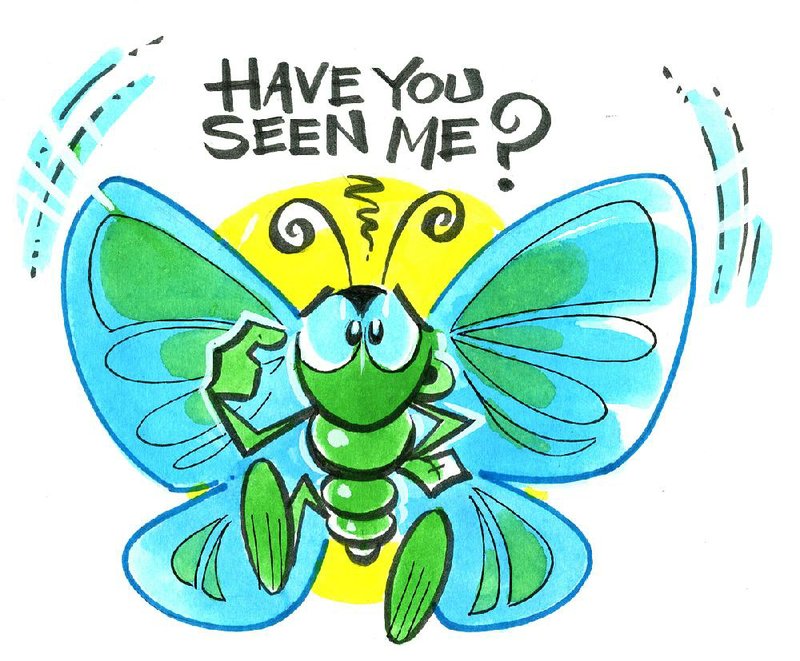DEAR READERS: A recent question concerning the apparent lack of butterflies this summer generated a lot of emails from all across Arkansas. Some folks say they have plenty of butterflies and bees, while others haven't seen any.
I have talked with our entomologists and other butterfly and bee authorities, and there is no definitive answer. Many factors could suppress the populations of butterflies and bees, including weather -- cool spring, extra rain, delayed season, the current intense heat and dry conditions.
Also, many emails commented on seeing more wasps than normal (they attack and eat caterpillars and their larvae), which could reduce the population.
The key is to plant a variety of flowers that can extend the growing season for the pollinators and make sure you are watering. I have plenty of pollinators in my garden, and have seen plenty of bumblebees and other solitary bees, plus the wasps; but I have fewer butterflies, even though I do grow milkweed, fennel and parsley. So hang in there, plant for pollinators and hope that we will begin to see more butterflies.
Q Can you identify the vine that is taking over in an area that is all peppermint plants? It is yellow and does not have any roots. This is the second year it has appeared and I don't like it. I want it out of the garden.
A The plant in question is an invasive weed called dodder. Dodder, commonly called love vine, is a parasitic annual weed. It starts growing from seed in the spring, and once it germinates, it attaches itself to the host plant and no longer has any roots. As a parasite, it gets all of its nourishment from the host. It wraps around the host. At first dodder is green, but it matures to yellow and finally almost to orange. As it matures, you will see tiny blossoms that produce seeds for next season. By late season, it looks very orange in color, and the host plant may be near death. Once dodder is established, your only recourse is to destroy the dodder and often the host plant -- especially if the host is an annual flower. Get out as much as possible. If you can catch it early enough, you can prevent seed formation and set. You can also use a pre-emergent herbicide in the beds in March to prevent a recurrence. There is nothing you can spray to kill it now. Your only remedy is to pull it and destroy it -- and the sooner the better.
Q I have mushrooms growing in a couple of my houseplants. What causes this to happen? Are they harmful to the plants? What do I need to do to correct this problem?
A Mushrooms grow wherever there are spores and enough moisture. They should not harm anything, but probably they are not what you want to see. Knock them down or dig them out and eventually they will go away.
Q I have a severe zoysia grass invasion in my blue rug juniper groundcover in several of my shrub beds. We have sprayed with Ortho Grass-B-Gon, but after five days have seen no evidence that it is working or going to work. The label lists a great number of grasses it will kill but zoysia is not one of them. Is there another herbicide you could recommend that might work on zoysia grass? I am afraid that we are going to have to use Roundup to kill and remove the zoysia and blue rugs, and that would be quite an undertaking. I would appreciate any advice you may have.
A Unfortunately there is nothing you can use to kill grass in juniper. I am surprised you didn't see some damage to the juniper from the Grass-B-Gon. Juniper is not very forgiving of herbicides. Your only recourse is hand-weeding, which is not fun, or you can remove the juniper and grass and plant something else. Sorry it isn't better news.
Q My husband and I recently looked at buying a fixer-upper house in Fayetteville. It's a great deal, on more than an acre, but needs a lot of work inside. However, the thing that is keeping me from really considering it is that there is a bunch of bamboo on one side of the house that is running rampant. Apparently it was planted to help with drainage problems (the house sits at the bottom of a hill) and to help privatize the area where an in-ground pool and hot tub sit (in the backyard). Would this be a deal breaker for you? Everything I've read about bamboo says that even the less invasive types are difficult, at best, and the worst types are almost impossible and can cause damage to your foundation. We are curious about your take on the problem.
A Although I truly hate running bamboo, if the house and grounds are a great deal, and you are willing to tackle the bamboo, I would not let that be a deal breaker. Do be aware that it will take a couple of years to eradicate the bamboo, but if you can cut it down and backhoe or till the area and keep raking out the runners, eventually you can win.
Janet B. Carson is a horticulture specialist for the University of Arkansas Cooperative Extension Service. Write to her at 2301 S. University Ave., Little Rock, Ark. 72204 or email her at
jcarson@arkansasonline.com
HomeStyle on 08/15/2015
